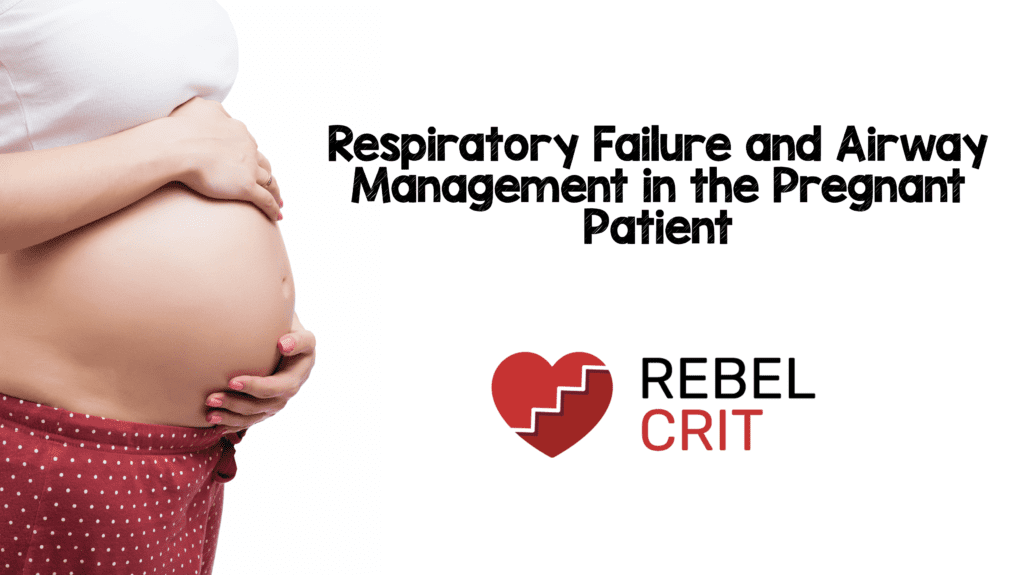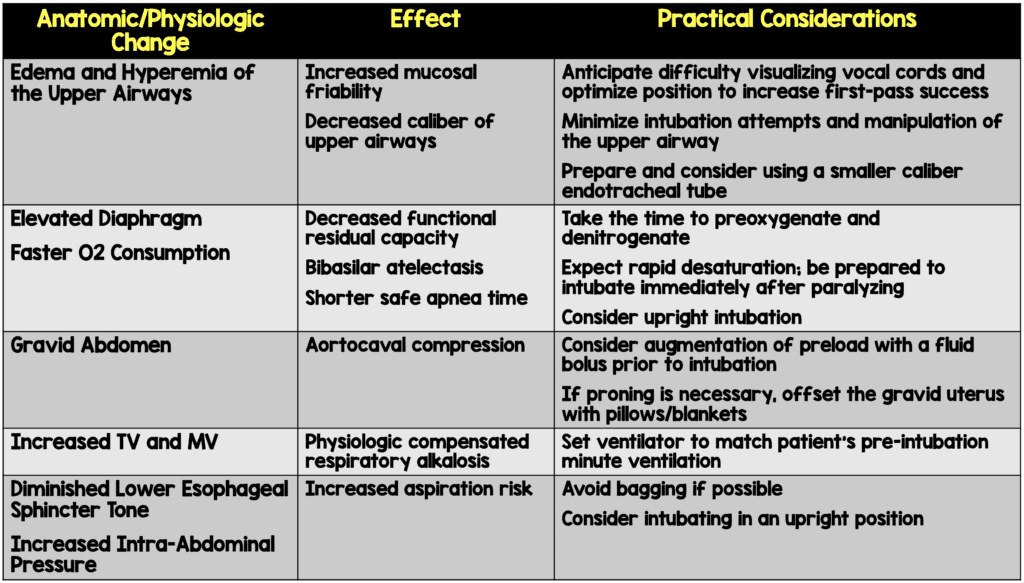
 Introduction: Respiratory failure is an uncommon but important complication in pregnancy and the postpartum period, occurring 1 in 500 pregnancies.1 Respiratory failure can result from pregnancy-related conditions, conditions exacerbated by pregnancy, or pathologies common to the general population (Table 1). Understanding of respiratory failure and mechanical ventilation in pregnant patients is limited by the relative rarity of the condition as well as the exclusion or underrepresentation of pregnant patients in the majority of the trials that have informed our understanding of respiratory failure. As such, respiratory failure in this vulnerable population is a stressful emergency that requires understanding of the anatomical and physiological changes of gestation as well as meticulous preparation for a difficult airway.
Introduction: Respiratory failure is an uncommon but important complication in pregnancy and the postpartum period, occurring 1 in 500 pregnancies.1 Respiratory failure can result from pregnancy-related conditions, conditions exacerbated by pregnancy, or pathologies common to the general population (Table 1). Understanding of respiratory failure and mechanical ventilation in pregnant patients is limited by the relative rarity of the condition as well as the exclusion or underrepresentation of pregnant patients in the majority of the trials that have informed our understanding of respiratory failure. As such, respiratory failure in this vulnerable population is a stressful emergency that requires understanding of the anatomical and physiological changes of gestation as well as meticulous preparation for a difficult airway.
Table 1: Causes of Respiratory Failure in Pregnancy

Physiology: Understanding of the physiologic changes in ventilation associated with pregnancy is paramount for the management of respiratory failure in pregnant patients and the interpretation of pre- and post-intubation blood gases. Acid-base status in pregnant patients depends on an extremely delicate balance: a degree of maternal alkalosis is necessary for the preferential transfer of carbon dioxide from fetal to maternal circulation for elimination but maternal hypocarbia also results in uteroplacental vasoconstriction and resultant fetal hypoperfusion and hypoxia.1 The resulting state is a mild, physiologic compensated respiratory alkalosis that allows for maternofetal gas exchange without compromising uteroplacental blood flow. This is achieved through a progesterone-mediated increase in tidal volume that drives PaCO2 to 28-32 mmHg and results in a compensatory decrease in bicarbonate to 18-21 mEq/L.2
Intubation: Failed intubation is eight times more likely in gravid patients than the general population.3,4 Therefore, a difficult airway should be anticipated and prepared for in all pregnant patients with impending respiratory failure. Understanding of the airway changes in pregnant patients can aid in preparation and the anticipation of difficulties in intubation. First, human placental growth hormone secreted in pregnancy increases blood flow to the upper airways, resulting in edema and hyperemia which decrease the caliber of the airways and increase their friability.3,5 This can also impair visualization of the vocal cords. A smaller caliber endotracheal tube and a supraglottic airway device should be prepared and available prior to attempting intubation in pregnant patients. Additionally, diaphragm elevation by the gravid uterus reduces functional residual capacity by 10-25% and results in basilar atelectasis.1 Oxygen consumption increases 20-33% above baseline by the third trimester and carbon dioxide production is similarly increased due to the metabolic demands of the fetus.5 These anatomic and metabolic changes result in a shorter safe apnea time and faster desaturation and hypoxemia, highlighting the importance of pre-induction oxygenation and denitrogenation. Gravid patients are also at increased risk of aspiration of gastric contents due to the progesterone-mediated decreased tone of the lower esophageal sphincter and increased intra-abdominal pressure from the enlarged uterus.5,6 Bag-mask ventilation should be avoided unless absolutely necessary, as this can likewise increase the risk of aspiration. Intubation in a semi-upright position should also be considered to mitigate the risk of aspiration in these patients and may have the added benefit of improving gas exchange through relief of uterine compression of the lung bases.6 Both rocuronium and succinylcholine have been studied for muscle relaxation in pregnant patients with comparable safety.7,8 The anticipated difficulty of the airway, rather than pregnancy status, should dictate the choice of agent in these patients. Similarly, there is no data to suggest the superiority of one induction agent over another in acute respiratory failure in pregnancy, and this choice of induction medications should be made based on patient hemodynamic factors and the underlying cause of respiratory failure. Finally, aortocaval compression by the gravid uterus in the supine pregnant patient may exacerbate peri-intubation hypotension by significantly reducing preload. Depending on the clinical context, some patients may benefit from intravenous volume expansion prior to induction or displacement of the uterus to minimize aortocaval compression and decrease the risk of hypotension and fetal hypoperfusion.
Table 2: The Impact of Anatomic and Physiologic Changes of Pregnancy on Respiratory Failure and Intubation

Mechanical Ventilation: Data on invasive mechanical ventilation (IMV) in pregnant patients is sparse and current practice is based on the extrapolation of general population data combined with current understanding of respiratory physiology in pregnancy. Data supports the use of low-tidal volume strategies in pregnant patients, with a goal of 6 ml/kg ideal body weight (IBW).9,10 Decreased compliance secondary to uterine enlargement may require an increase in peak airway pressures slightly above the conventional limit of 30 cm H2O to allow for adequate ventilation in patients near term.1 The limits of peak airway pressure in pregnancy are unknown, and while a slight increase to overcome decreased compliance in these patients should not increase transpulmonary pressure, care should be taken not to cause pulmonary barotrauma. Uterine compression of the lungs may likewise necessitate higher positive end-expiratory pressure (PEEP) to improve basilar recruitment. Again, optimal PEEP in these patients is unknown and precautions should be taken to prevent ventilator-associated lung injury when possible.
Oxygenation goals in the IMV of pregnant patients are complicated by the oxygen requirements of the fetus, which depends heavily on maternal PaO2. A saturation of 94% is currently recommended for pregnant patients on IMV, although there is limited data to support this oxygenation goal.1 In addition to maternal PaO2, fetal oxygenation also depends on maternal hemoglobin levels, maternal acid-base status, and uteroplacental perfusion. These factors should also be optimized to minimize fetal hypoxia. Similarly, little is known regarding optimal CO2 levels in pregnant patients on IMV. Hypocarbia in the pregnant population is known to be harmful, as the resultant alkalosis leads to uteroplacental vasoconstriction and fetal hypoxia.10 Permissive hypercapnia is commonly practiced in the general population but its effects in pregnancy are unknown. Current practice is to allow mild hypercapnia for the sake of lung protective ventilation, but there is no data to date to support or refute this strategy.
Conclusion: Respiratory failure in pregnancy is an uncommon but complex emergency. Understanding of the anatomic and physiologic changes associated with pregnancy can aid in the management of respiratory failure in these patients. Every pregnant patient should be treated as a potential difficult airway and contingency plans should be in place should first-pass intubation not be successful. Data on IMV in pregnancy is limited and practice is largely extrapolated from data on the general population.
Guest Post By:

Marina Boushra, MD
Critical Care Fellow
The Respiratory Institute, Cleveland Clinic
References:
- Lapinsky SE. Acute respiratory failure in pregnancy. Obstetric Medicine. 2015. PMID: 28561251
- Archer GW et al. Arterial oxygen tension during apnea in parturient women. BJA. 1974. PMID: 4157184
- Biro, P. Difficult intubation in pregnancy. Current Opinions in Anaesthesiology. 2011. PMID: 1451403
- King TA et al. Failed tracheal intubation. British Journal of Anaesthesia. 1990. PMID: 2223369
- Bhatia P et al. Physiological and anatomical changes of pregnancy: Implications for anaesthesia. Indian Journal of Anaesthesia. PMID: 30237589
- Mushambi MC et al. Obstetric Anaesthetists’ Association and Difficult Airway Society guidelines for the management of difficult and failed tracheal intubation in obstetrics. Anaesthesia. 2015. PMID: 26449292
- Ward SJ et al. Neuromuscular blocking drugs in pregnancy and the puerperium. International Journal of Obstetric Anesthesia. 1998. PMID: 15321189
- Guay J et al. Clinical pharmacokinetics of neuromuscular relaxants in pregnancy. Clinical Pharmacokinetics. 1998. PMID: 9646009
- Cole DE et al. Acute respiratory distress syndrome in pregnancy. Critical Care Medicine. 2005. PMID: 16215347
- Pandya ST et al. Critical care in obstetrics. Indian Journal of Anaesthesia. 2018. PMID: 30237599
Post Peer Reviewed By: Salim R. Rezaie, MD (Twitter: @srrezaie)
The post Respiratory Failure and Airway Management in the Pregnant Patient appeared first on REBEL EM - Emergency Medicine Blog.
